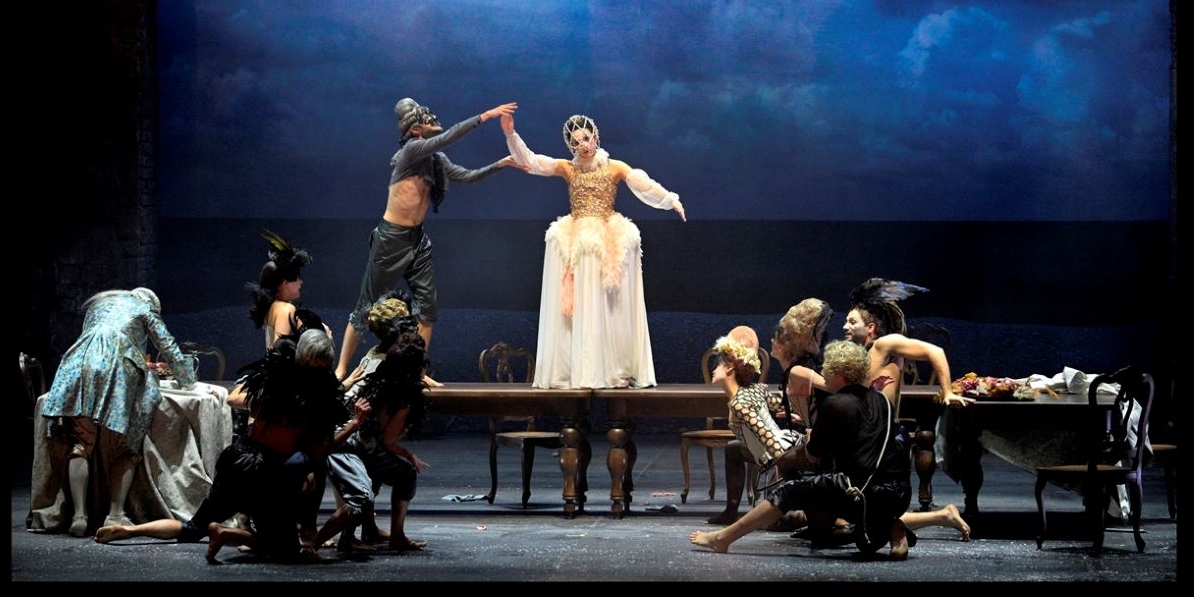Lurcanio is in love with Dalinda, but she is in love with Polinesso, Duke of Albany, who is in love with Ginevra, daughter of the king of Scotland, who loves prince Ariodante, brother of Lurcanio. Now the prince loves her back and wants to marry her, and the king is happy with the arrangement, but Polinesso is not willing to accept rejection, and exploits Dalinda’s devotion to him to fool Ariodante into believing that Ginevra is unfaithful to him. This circular plot might sound like a comedy, but Handel’s Ariodante is considered an opera seria. He composed it in 1735, same year in which he wrote Alcina, which was also inspired by Ludovico Ariosto’s Orlando Furioso. Last year, a truncated Alcina was performed at the Israeli Opera as a variation on film noir. Ariodante, however, is presented in its full length of three and a half hours.
This was my first encounter with this baroque opera, which has only recently become the Handel opera du jour, with new productions popping up all over Europe. My impression was that the music is very beautiful, but the dramatic structure is flawed. Each aria – most of them about love – is long and repeats the same phrase numerous times. Yet, the few scenes in which the plot moves forward – as in when Dalinda confesses her offence and begs the king for forgiveness – everything happens very quickly and all potential for drama fades away.
Celebrated Scots director Sir David McVicar’s production, first performed in 2017 at the Vienna State Opera, is mostly classic in approach. The set designed by Vicki Mortimer is composed of a huge sea and sky scrim behind simple high stone walls which shift to form various scenes. An enormous dead deer dragged on the stage in one scene, hanging in the air in another, echoes Polinesso’s trap and its victims. Other furniture items that appear in different scenes include a festive dinner tables, massive bookcases and gorgeous chandeliers. However, too often a screen that looks like a steel wall comes down to allow a change of scenery.
Mortimer also designed the colorful and opulent 18th century silk, satin, and velvet brocade costumes. Plumed hats and fancy high heeled shoes worn by both men and women complete the look. Ariodante is Handel’s first opera to include dance music, originally composed for dancer Marie Sallé and her company. Colm Seery’s choreography is inventive and whimsical. The men’s moves are a mix of classic ballet and Scottish Highland dances from the 18th and 19th centuries. The women’s dances are coquettish and in one of the highlights of the production Ginevra joins the dancers while singing. A dancing soprano is not a common sight in operas, and Daniela Skorka combined the two feats gracefully. Later in the evening, the heartbroken princess envisions a ballet of Good and Bad in which a mannequin double of herself is shamed and violated by malevolent accusers. The symbolic image of a woman as a doll is by now an overused cliché, and the choreography of the scene wasn’t as inspired as the earlier dances.
Happily, the leading characters were all performed very well. American counter tenor Nicholas Tamagna was impressive as the Machiavellian Polinesso who has no qualms about getting what he wants. Israeli Soprano Daniela Skorka has a rich honey-pure voice, and she acted beautifully Ginevra’s metamorphosis from a joyful narcissistic princess to a scorned and broken woman who wishes to die. The role of Ginevra is the most demanding in the opera, and Skorka was in full control of every note and tone of sound. American mezzo soprano Cecilia Hall, dressed in men’s attire, was also very good in the title role. As Dalinda, Polinesso’s easily duped accomplice, Israeli soprano Hila Fahima had some excellent moments, but here and there her voice sounded a little flat. Handsome British tenor Ed Lyon who sang Lurcanio, has a truly beautiful voice, though he didn’t seem to be invested in the acting part of his role.
The regular opera orchestra was replaced by Israeli Baroque Collective, with the participation of the Ensemble Matheus of Jean-Christophe Spinosi, who also conducted. The sound wasn’t as crisp as one could wish but they mostly did a good job. In general the production is quite handsome, even if there doesn’t seem to be much of an interpretation that would add to the inner drama of the characters.

